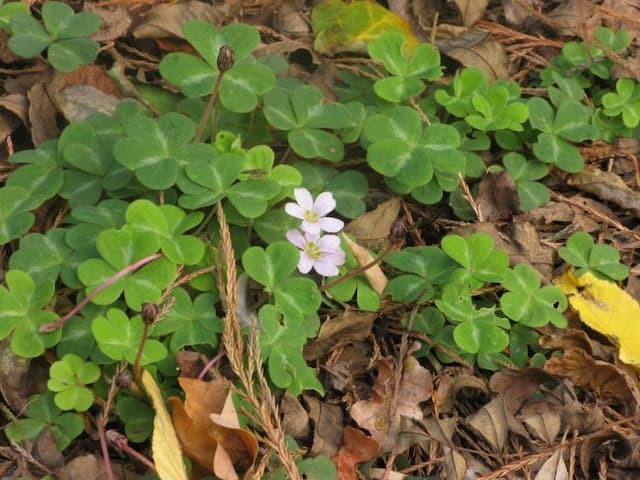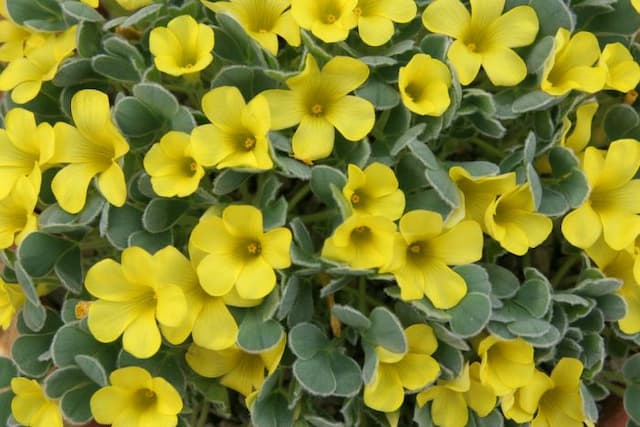Purple Shamrock Oxalis triangularis subsp. papilionacea

ABOUT
The plant commonly known as the purple shamrock or false shamrock, carries a striking appearance primarily due to its rich purple, triangular leaves that sit symmetrically in groups of three, much like clover leaves. These leaves are attached to slender, fibrous stems that elegantly arrange themselves in a way that maximizes their exposure to light. The foliage often has a velvety texture that further accentuates its vivid coloration, which can range from deep purple to plum, with some varieties also showing shades of green. Additionally, the plant produces small, delicate flowers that can range in color from white to pale pink. These flowers are tubular and rise above the foliage on thin stalks, adding a fine, ornamental quality to the already captivating leaf display. The contrast between the soft flowers and the dramatic leaves makes for a visually appealing combination. The purple shamrock is known for its nyctinastic movements, meaning that it opens and closes not only its flowers but also its leaves in response to light, creating a dynamic display that changes from day to night. This plant is favored for both its ornamental beauty and its ability to adapt to indoor environments, making it a popular choice for houseplant enthusiasts. It adds a touch of elegance and color to interiors and garden settings alike, without needing to account for large spatial accommodations. The overall appearance of the purple shamrock is one that exudes both charm and a touch of mystery, enveloping any space with its unique and animated character.
About this plant
 Names
NamesFamily
Oxalidaceae
Synonyms
Purple Shamrock, False Shamrock, Love Plant, Purple Clover
Common names
Oxalis regnellii var. triangularis, Oxalis papilionacea, Oxalis purpurea, Oxalis regnellii, Ionoxalis triangularis, Acetosella regnellii, Acetosella triangularis, Oxalis regnellii f. triangularis, Oxalis triangularis f. triangularis, Oxalis triangularis var. papilionacea.
 Toxicity
ToxicityTo humans
The plant commonly known as purple shamrock is considered mildly toxic to humans when ingested. The toxicity comes from oxalic acid and oxalate crystals present in the leaves. If eaten in large quantities, it may cause symptoms such as nausea, vomiting, diarrhea, and abdominal pain. In rare cases, kidney stones may form due to the accumulation of oxalates in kidneys. However, poisoning from incidental ingestion is generally low risk, with most cases being mild and self-limiting.
To pets
The purple shamrock plant is toxic to pets, including dogs and cats, due to its content of soluble oxalate crystals. Ingestion can lead to symptoms of toxicity such as drooling, vomiting, diarrhea, decreased appetite, and lethargy. In severe cases, more serious symptoms like tremors, kidney failure, or even death could occur if large amounts are ingested. Prompt veterinary attention is recommended if a pet consumes this plant.
 Characteristics
CharacteristicsLife cycle
Perennials
Foliage type
Deciduous
Color of leaves
Purple
Flower color
Pink
Height
0.5 feet (15 cm)
Spread
1 feet (30 cm)
Plant type
Bulb
Hardiness zones
8
Native area
Brazil
Benefits
 General Benefits
General Benefits- Easy to care for: Oxalis triangularis, commonly known as purple shamrock, is relatively low maintenance and can thrive with minimal care.
- Aesthetic appeal: Its distinctive purple leaves and small pink flowers add a unique and vibrant touch to any indoor or outdoor space.
- Foliage movement: The leaves of the purple shamrock open and close in response to light, making it an interesting plant to observe.
- Feng Shui: Some believe the plant can bring good luck and positive energy into the home, according to Feng Shui principles.
- Drought-tolerant: The purple shamrock is quite resilient and can withstand periods of drought, making it suitable for forgetful owners.
- Rapid growth: It can grow and propagate quickly, filling a space with greenery in a short amount of time.
- Non-toxic to pets: The plant is generally considered non-toxic, making it safe for homes with pets.
- Seasonal interest: Purple shamrock may go dormant in the winter, allowing for a change in scenery and signaling a natural life cycle.
 Medical Properties
Medical PropertiesThis plant is not used for medical purposes.
 Air-purifying Qualities
Air-purifying QualitiesThis plant is not specifically known for air purifying qualities.
 Other Uses
Other Uses- Oxalis triangularis, commonly known as the purple shamrock, can be used in butterfly gardens as its flowers attract pollinators such as bees and butterflies.
- The plant can be grown as a ground cover in shady areas, where its distinctive leaves can create a lush, purple carpet.
- The leaves are sometimes used as a garnish for food plating due to their unique color and shape, adding visual appeal to dishes.
- Oxalis triangularis can be used in educational settings to demonstrate nyctinastic movement – the daily night closure of leaves as a reaction to light changes.
- In crafting, the bright purple leaves can be pressed and used to create natural art pieces or to decorate hand-crafted cards.
- The plant can be potted in small containers and used as a living decoration for offices or homes where limited space is available.
- Its vivid purple foliage offers a dramatic contrast in mixed container plantings, alongside green-leafed plants.
- For special occasions like St. Patrick’s Day, it’s often used as a decorative plant due to its association with shamrocks and luck.
- Purple shamrock can be used as a teaching tool for children or beginners in gardening to learn about plant care and propagation.
- The rapid opening and closing of the leaves can serve as an interesting time-lapse subject for photographers and videographers.
Interesting Facts
 Feng Shui
Feng ShuiThe Purple Shamrock is not used in Feng Shui practice.
 Zodiac Sign Compitability
Zodiac Sign CompitabilityThe Purple Shamrock is not used in astrology practice.
 Plant Symbolism
Plant Symbolism- Luck: Often referred to as the "Purple Shamrock" or "False Shamrock," this plant is commonly associated with good fortune and luck due to its resemblance to the traditional Irish shamrock.
- Balance: The Purple Shamrock's leaves unfold and close with the light, symbolizing balance and adaptation to life’s rhythms.
- Transcendence: With its rich purple color, the plant is sometimes linked to spiritual awareness and upliftment.
- Magic: Due to its unique appearance and rapid movement, the Purple Shamrock is often associated with magic and the unexpected.
- Love: In the Victorian language of flowers, the Oxalis triangularis is said to represent love, making it an ideal gift between romantic partners.
 Water
WaterPurple Shamrock requires consistent moisture, so it should be watered when the top inch of soil feels dry. On average, this may mean watering once every week, but this frequency can vary depending on environmental conditions such as temperature and humidity. Always water thoroughly, allowing excess water to drain away, which could amount to around 8-16 ounces for a small to medium-sized pot every time you water. During the plant's dormant period in the winter, reduce watering frequency as the plant’s water requirements decrease.
 Light
LightPurple Shamrocks thrive in bright, indirect sunlight. A spot near an east or north-facing window where it can receive a few hours of gentle morning sun followed by indirect light is ideal. Avoid prolonged exposure to direct afternoon sunlight as it can scorch the leaves, but keep in mind that insufficient light may lead to leggy stems and poor leaf coloration.
 Temperature
TemperaturePurple Shamrock prefers temperatures between 60°F and 75°F, which is comfortable room temperature for most homes. This plant can survive minimum temperatures down to around 50°F, but it should not be exposed to temps below this as it can damage the plant. Avoid placing it near drafts, heating, or air conditioning vents where temperature fluctuations are common.
 Pruning
PruningPurple Shamrock benefits from pruning primarily to remove any dead or yellowing leaves to keep the plant looking its best and to encourage new growth. Pruning is generally done as needed, rather than on a strict schedule. The best time for pruning is during the active growing season in the spring and summer when the plant can easily recover and produce new leaves.
 Cleaning
CleaningAs needed
 Soil
SoilPurple Shamrock thrives in well-draining potting mix with a slight acidic to neutral pH of 6.0 to 7.0. A good soil mixture would be a blend of potting soil, peat moss, and perlite or sand to improve drainage. Ensure the pot has drainage holes to avoid water accumulation.
 Repotting
RepottingPurple Shamrock should generally be repotted every 2 to 3 years or when it becomes root-bound. Use a slightly larger pot to give the new roots room to grow and refresh the soil to provide new nutrients.
 Humidity & Misting
Humidity & MistingPurple Shamrock prefers moderate to high humidity levels, around 50% to 75%. If the air in your home is too dry, consider using a humidifier or placing the pot on a tray of pebbles with water to increase the surrounding humidity.
 Suitable locations
Suitable locationsIndoor
Place Purple Shamrock in bright, indirect light indoors.
Outdoor
Grow Purple Shamrock in dappled shade outside.
Hardiness zone
7-11 USDA
 Life cycle
Life cycleThe life of the Purple Shamrock (Oxalis triangularis subsp. papilionacea) typically begins with the germination of a small, sclerified bulb known as a bulbil, which sprouts into a seedling with characteristic triangular, purple leaves. As it grows, the plant develops a small stem and more leaves, entering the vegetative stage where it focuses on growth and photosynthesis. During the flowering stage, the Purple Shamrock produces delicate, light pink to white flowers that can lead to the production of seeds if pollinated. After flowering, the plant often enters a dormancy phase, especially in cooler climates or during winter months, where the foliage dies back and the bulbil conserves energy. With the onset of favorable conditions like warmer temperatures and increased daylight, the plant will break dormancy, regrowing from the bulbil to repeat the cycle. Throughout its life, the Purple Shamrock will continuously produce new bulbils that can detach and give rise to new plants, hence propagating vegetatively.
 Propogation
PropogationPropogation time
Spring-Early Summer
Oxalis triangularis, commonly known as Purple Shamrock or False Shamrock, is typically propagated through division, which is best done in the spring as new growth begins. This popular method involves gently separating the bulb-like structures, known as corms, which develop at the base of the plant. With clean hands or a tool, carefully tease apart the corms ensuring that each division has at least one growth point or an attached portion of the original plant's roots. Then, plant the individual corms about 1 to 2 inches deep (2.5 to 5 centimeters) in a well-draining potting mix. Water the newly planted corms thoroughly and place them in a location that receives indirect light. They should begin to sprout new shoots in a few weeks, given the right conditions. It is crucial to avoid overwatering as this can cause the corms to rot.









